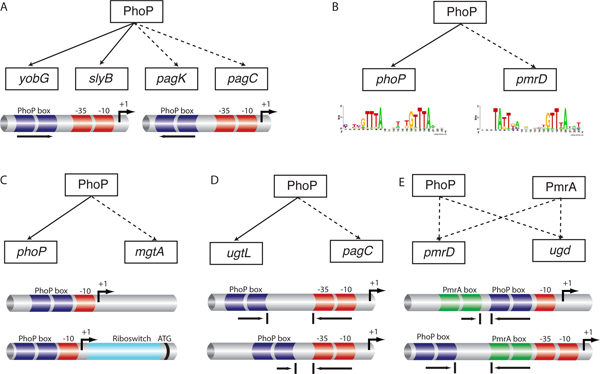Figure 4.
The PhoP protein exhibits different cis-features for genes within the same network motif. (A) PhoP-regulated promoters that differ in the orientation of the PhoP-binding site. PhoP regulates a set of promoters including those of the Salmonella yobG, slyB, pagK and pagC genes using a single-input network motif. We established that when Salmonella experiences low Mg2+, the PhoP protein binds to both the archetypal directly oriented yobG and slyB promoters as well as the oppositely oriented pagK and pagC promoters using chromatin immunoprecipitation (ChIP) in vivo [56]. (B) The PhoP protein uses the single-input network motif to control genes that differ in their binding site pattern. The PhoP protein recognizes a binding site motif consisting of a hexameric direct repeat separated by 5 bp, but distinguishes between different patterns with different specificities (i.e. phoP and pmrD). (C) PhoP regulates the phoP and mgtA Salmonella genes using the same network motif, however, mgtA harbors a riboswitch pattern in its 5'UTR region. (D) PhoP-regulated promoters differ in the RNA polymerase sites. The PhoP-activated ugtL and pagC promoters share the orientation of the PhoP-binding site as well as the class I sigma 70 promoter, but differ in the distance between the PhoP box and the RNA polymerase site. (E) Expression of PhoP-regulated promoters that use the bi-fan network motif. The Salmonella pmrD, and ugd promoters harbor experimentally verified PhoP- and PmrA-binding sites that can be described by the bi-fan network motif. The distance between the PhoP and PmrA boxes in the Salmonella pmrD and ugd promoters are also different (~38 bp and ~65 bp, respectively).

